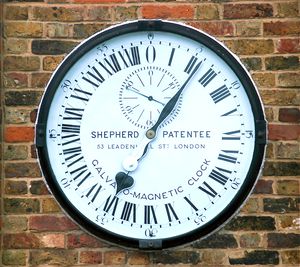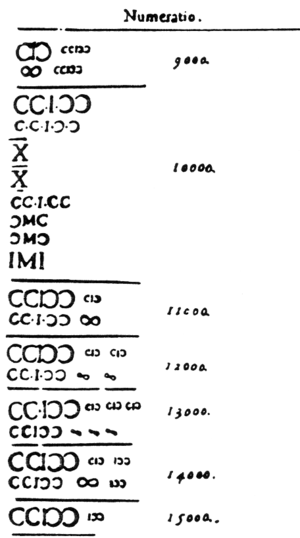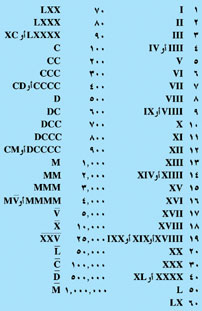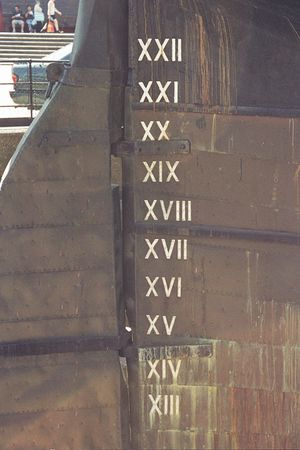الأعداد الرومانية
| جزء من سلسلة عن |
| أنظمة العد |
|---|
| قائمة نظم العد |

الأرقام الرومانية Romanian numbers رموز تُعبِّر عن أرقام، وتُكتب كل الأعداد الرومانية باستخدام سبعة رموز أساسية، إما منفردة وإما مـركّبة. وتشمل هذه الرموز السبعة:
M ، (500) D ، (100) C ، (50) L ، (10) X ، (5) V ، (1) I (ألف).
وتُكتب الأعداد الرومانية من اليسار إلى اليمين، باستخدام مبدأ الإضافة في معظم الحالات، فتُكتب الآلاف أولا تليها المئات ثم العشرات وأخيراً الآحاد. ويكتب اليوم الوطني الماسي للمملكة العربية السعودية، (مرور 75 عامًا على تأسيسها) بالتقويم الميلادي، الذي يصادف سنة 2007، كالآتي: MMVII.
في نظام الأعداد الرومانية ، يكون وضع عدد أصغر قبل عدد أكبر، معناه أن الرقم الأصغر مطروح من الرقم الأكبر. ويُستخدم هذا المبدأ عموماً في الأربعات والتسعات. وعلى ذلك فإن رقم 4 يُكتب IV 1-5 ، كما يكتب رقم 9 بالشكل IX 1-10 وعادة ما ينطبق هذا المبدأ على أي رقم يبدأ بعدد 4، أو 9 مثل؛ 40 XI، و 90 XC ، ومع ذلك ، يمكن أيضًا استخدام مبدأ الجمع في كتابة مثل هذه الأعداد. فمثلا يمكن كتابة 400 بالشكل CCCC بدلاً من CD .
رموز
| Symbol | Value |
|---|---|
| I | 1 (one) ([unus] Error: {{Lang}}: text has italic markup (help)) |
| V | 5 (five) ([quinque] Error: {{Lang}}: text has italic markup (help)) |
| X | 10 (ten) ([decem] Error: {{Lang}}: text has italic markup (help)) |
| L | 50 (fifty) ([quinquaginta] Error: {{Lang}}: text has italic markup (help)) |
| C | 100 (one hundred) ([centum] Error: {{Lang}}: text has italic markup (help)) |
| D | 500 (five hundred) ([quingenti] Error: {{Lang}}: text has italic markup (help)) |
| M | 1000 (one thousand) ([mille] Error: {{Lang}}: text has italic markup (help)) |
- V or (V) for five thousand
- X or (X) for ten thousand
- L or (L) for fifty thousand
- C or (C) for one hundred thousand
- D or (D) for five hundred thousand
- M or (M) for one million
المضاعفات الأساسية للالأرقام الرومانية
| ×1 | ×2 | ×3 | ×4 | ×5 | ×6 | ×7 | ×8 | ×9 | |
|---|---|---|---|---|---|---|---|---|---|
| Ones | I | II | III | IV | V | VI | VII | VIII | IX |
| Tens | X | XX | XXX | XL | L | LX | LXX | LXXX | XC |
| Hundreds | C | CC | CCC | CD | D | DC | DCC | DCCC | CM |
| Thousands | M | MM | MMM | IV | V | VI | VII | VIII | IX |
| Ten thousands | X | XX | XXX | XL | L | LX | LXX | LXXX | XC |
| Hundred thousands | C | CC | CCC | CD | D | DC | DCC | DCCC | CM |
الكسور
| Fraction | Roman Numeral | Name (nominative and genitive) | Meaning |
|---|---|---|---|
| 1/12 | • | [uncia, unciae] Error: {{Lang}}: text has italic markup (help) | "ounce" |
| 2/12 = 1/6 | •• or : | [sextans, sextantis] Error: {{Lang}}: text has italic markup (help) | "sixth" |
| 3/12 = 1/4 | ••• or ∴ | [quadrans, quadrantis] Error: {{Lang}}: text has italic markup (help) | "quarter" |
| 4/12 = 1/3 | •••• or :: | [triens, trientis] Error: {{Lang}}: text has italic markup (help) | "third" |
| 5/12 | ••••• or :•: | [quincunx, quincuncis] Error: {{Lang}}: text has italic markup (help) | "five-ounce" (quinque unciae → quincunx) |
| 6/12 = 1/2 | S | [semis, semissis] Error: {{Lang}}: text has italic markup (help) | "half" |
| 7/12 | S• | [septunx, septuncis] Error: {{Lang}}: text has italic markup (help) | "seven-ounce" (septem unciae → septunx) |
| 8/12 = 2/3 | S•• or S: | [bes, bessis] Error: {{Lang}}: text has italic markup (help) | "twice" (as in "twice a third") |
| 9/12 = 3/4 | S••• or S:• | [dodrans, dodrantis] Error: {{Lang}}: text has italic markup (help) or [nonuncium, nonuncii] Error: {{Lang}}: text has italic markup (help) |
"less a quarter" (de-quadrans → dodrans) or "ninth ounce" (nona uncia → nonuncium) |
| 10/12 = 5/6 | S•••• or S:: | [dextans, dextantis] Error: {{Lang}}: text has italic markup (help) or [decunx, decuncis] Error: {{Lang}}: text has italic markup (help) |
"less a sixth" (de-sextans → dextans) or "ten ounces" (decem unciae → decunx) |
| 11/12 | S••••• or S:•: | [deunx, deuncis] Error: {{Lang}}: text has italic markup (help) | "less an ounce" (de-uncia → deunx) |
| 12/12 = 1 | I | [as, assis] Error: {{Lang}}: text has italic markup (help) | "unit" |


الأستخدامات الحديثة
| Roman numeral | I | ii | iii | IV | V | vi | vii° |
| Scale degree (major mode) |
tonic | supertonic | mediant | subdominant | dominant | submediant | leading tone |
| Roman numeral | i | ii° | III | iv | v | VI | (♭)VII | vii° |
| Scale degree (minor mode) |
tonic | supertonic | mediant | subdominant | dominant | submediant | subtonic | leading tone |
الاستخدام لغير الناطقين بللغة الإنجليزية
| I | 9:30-17:30 |
| II | 9:30-19:00 |
| III | 9:30-17:30 |
| IV | 9:30-17:30 |
| V | 9:30-19:00 |
| VI | 9:30-13:00 |
| VII | — |
أشكال بديلة

| Base number | CIƆ = 1,000 | CCIƆƆ = 10,000 | CCCIƆƆƆ = 100,000 | |
|---|---|---|---|---|
| 1 extra Ɔ | IƆ = 500 | CIƆƆ = 1,500 | CCIƆƆƆ = 10,500 | CCCIƆƆƆƆ = 100,500 |
| 2 extra Ɔs | IƆƆ = 5,000 | CCIƆƆƆƆ = 15,000 | CCCIƆƆƆƆƆ = 105,000 | |
| 3 extra Ɔs | IƆƆƆ = 50,000 | CCCIƆƆƆƆƆƆ = 150,000 |
الأرقام الرومانية في القرون الوسطى
| Modern number |
Medieval abbreviation |
Notes |
|---|---|---|
| 5 | A | Resembles an upside-down V. Also said to equal 500. |
| 6 | ↅ | Either a ligature of VI, or the Greek letter stigma (Ϛ), having the same numerical value.[1] |
| 7 | S, Z | Presumed abbreviation of septem, Latin for 7. |
| 11 | O | Presumed abbreviation of (e.g.) onze, French for 11. |
| 40 | F | Presumed abbreviation of English forty. |
| 70 | S | Also could stand for 7, and has same etymology. |
| 80 | R | |
| 90 | N | Presumed abbreviation of nonaginta, Latin for 90. |
| 150 | Y | Possibly derived from the lowercase y's shape. |
| 151 | K | This unusual abbreviation's origin is unknown; it has also been said to stand for 250. |
| 160 | T | Possibly derived from Greek tetra, as 4 x 40 = 160. |
| 200 | H | |
| 250 | E | |
| 300 | B | |
| 400 | P, G | |
| 500 | Q | Redundant with D, abbreviation for quingenti, Latin for 500. |
| 800 | W | More properly, the Greek ω, as W was a fairly new creation. |
| 900 | ĵ, ↑ | Resembled a crooked up arrow. |
| 2000 | Z |
الأرقام الرومانية الحديثة
| Standard | Arabic | Notes |
|---|---|---|
| none | 0 | N for nulla was used at least once (by Bede about 725). |
| I | 1 | |
| II | 2 | |
| III | 3 | |
| IV | 4 | IIII is still used on clock and Tarot card faces. See Calendars and clocks above. |
| V | 5 | IIIII was used rarely in the Middle Ages. |
| VI | 6 | |
| VII | 7 | |
| VIII | 8 | IIX was used rarely in the Middle Ages. |
| IX | 9 | |
| X | 10 | VV was used rarely in the Middle Ages. |
| XI | 11 | |
| XII | 12 | |
| XIII | 13 | |
| XIV | 14 | |
| XV | 15 | |
| XVI | 16 | |
| XVII | 17 | |
| XVIII | 18 | |
| XIX | 19 | |
| XX | 20 | |
| XXI | 21 | |
| XXV | 25 | |
| XXX | 30 | |
| XXXV | 35 | |
| XL | 40 | |
| XLV | 45 | |
| XLIX | 49 | Per rule above, IL would not be generally accepted. |
| L | 50 | |
| LX | 60 | |
| LXIX | 69 | |
| LXX | 70 | The abbreviation for the Septuagint |
| LXXVI | 76 | |
| LXXX | 80 | |
| XC | 90 | |
| XCIX | 99 | As opposed to the "shortcut" way IC seen above. |
| C | 100 | This is the origin of using the slang term "C-bill" or "C-note" for "$100 bill". |
| CL | 150 | |
| CC | 200 | |
| CCC | 300 | |
| CD | 400 | |
| D | 500 | |
| DC | 600 | |
| DCLXVI | 666 | Using every symbol except M in descending order gives the beast number. |
| DCC | 700 | |
| DCCC | 800 | |
| CM | 900 | |
| M | 1,000 | |
| MCDXLIV | 1,444 | Smallest pandigital number (each symbol is used) |
| MDCLXVI | 1,666 | Largest efficient pandigital number (each symbol occurs exactly once) |
| MDCCCLXXXVIII | 1,888 | Longest number when written (excluding multiple M's) |
| MCMXC | 1,990 | Shortcuts like XMM and MXM disagree with the rule stated above |
| MCMXCVII | 1,997 | |
| MCMXCIX | 1,999 | Shortcuts like IMM and MIM disagree with the rule stated above |
| MM | 2,000 | |
| MMI | 2,001 | |
| MMIX | 2,009 | |
| MMD | 2,500 | |
| MMM | 3,000 | |
| IV | 4,000 | sometimes MMMM[بحاجة لمصدر] or MV |
| V | 5,000 | |
| VMDCLXVI | 6,666 | This number uses every symbol up to V once. |
| X | 10,000 | |
| L | 50,000 | |
| C | 100,000 | |
| D | 500,000 | |
| M | 1,000,000 |
An accurate way to write large numbers in Roman numerals is to handle first the thousands, then hundreds, then tens, then units.
Example: the number 1988.
One thousand is M, nine hundred is CM, eighty is LXXX, eight is VIII.
Put it together: MCMLXXXVIII.
Unicode
| Code | 0 | 1 | 2 | 3 | 4 | 5 | 6 | 7 | 8 | 9 | A | B | C | D | E | F |
|---|---|---|---|---|---|---|---|---|---|---|---|---|---|---|---|---|
| Value[2] | 1 | 2 | 3 | 4 | 5 | 6 | 7 | 8 | 9 | 10 | 11 | 12 | 50 | 100 | 500 | 1,000 |
| U+2160 | Ⅰ | Ⅱ | Ⅲ | Ⅳ | Ⅴ | Ⅵ | Ⅶ | Ⅷ | Ⅸ | Ⅹ | Ⅺ | Ⅻ | Ⅼ | Ⅽ | Ⅾ | Ⅿ |
| U+2170 | ⅰ | ⅱ | ⅲ | ⅳ | ⅴ | ⅵ | ⅶ | ⅷ | ⅸ | ⅹ | ⅺ | ⅻ | ⅼ | ⅽ | ⅾ | ⅿ |
| Value | 1000 | 5000 | 10,000 | – | – | 6 | 50 | 50,000 | 100,000 | |||||||
| U+2180 | ↀ | ↁ | ↂ | Ↄ | ↄ | ↅ | ↆ | ↇ | ↈ | |||||||
أنظر أيضاً
المصادر
- الموسوعة المعرفية الشاملة
- Menninger, Karl (1992). Number Words and Number Symbols: A Cultural History of Numbers. Dover Publications. ISBN 0-486-27096-3.
وصلات خارجية
- Conversion algorithm and demonstration program (with java source code) for numbers up to 3,999
- Conversion program (with javascript source code) for numbers up to 3,999,999
- FAQ #1 Why do clocks with Roman numerals use "IIII" instead of "IV"?:
- Minor history of the rules of Roman Numerals and an Arabic to Roman Numeral Converter
- Online Converter for Decimal/Roman Numerals (JavaScript, GPL)
- Roman Numeral Conversion Exercises (Java)
- Romance in Numbers by Paul Niquette
- Simple Roman Numeral Converter in C (C)
- Web Based Converter - Decimal to Roman Numerals
- French book with 841 chapters, numbered up to DCCCXLI
| الأبجدية اللاتينية المعاصرة الأساسية | |||||||||||||||||||||||||
|---|---|---|---|---|---|---|---|---|---|---|---|---|---|---|---|---|---|---|---|---|---|---|---|---|---|
| Aa | Bb | Cc | Dd | Ee | Ff | Gg | Hh | Ii | Jj | Kk | Ll | Mm | Nn | Oo | Pp | Rr | Ss | Tt | Uu | Vv | Ww | Xx | Yy | Zz | |
|
التاريخ • علم الخطاطة • المشتقات • التشكيل • punctuation • الأرقام • يونيكود • قائمة الحروف • ISO/IEC 646 | |||||||||||||||||||||||||
- ^ Perry, David J. Proposal to Add Additional Ancient Roman Characters to UCS.
- ^ For the first two rows



